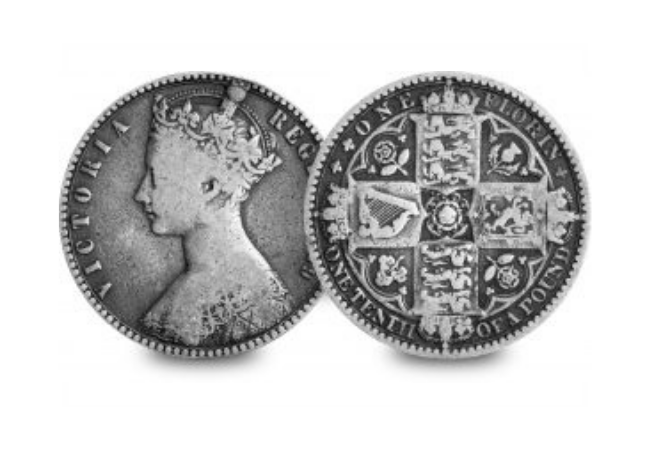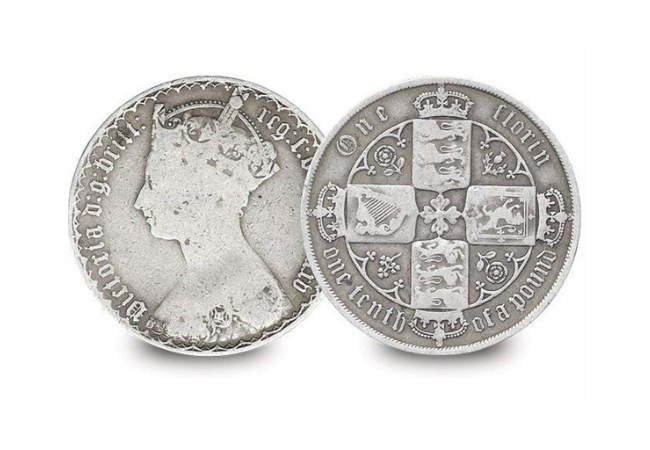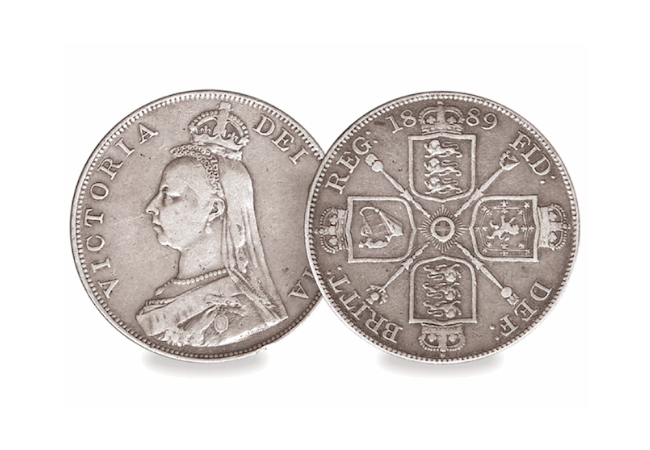The Victorian attempts at decimalisation that didn’t quite go to plan…
Next month marks the 50th anniversary since the UK switched to decimal currency, leaving behind the old Pounds (£), Shillings (/-) and Pence (d) and introducing the decimalised coins we know today. You might even remember Decimal Day in 1971 yourself, using conversion charts and rhymes to learn the new currency and the excitement of seeing the new coins in your change.
In the 1820s, discussions for a new decimal currency had already begun, and in 1849 a new decimal coin was introduced in the UK. But its introduction didn’t quite go as planned and decimalisation was delayed for almost 130 years!

The Florin
The Florin first entered circulation in 1849 and had a value of 1/10th of a pound, or 24 pence (in old money). Supposedly, the name came from a similar coin issued in the Netherlands to help with decimalisation there. The Florin (or Two Shilling Coin) featured a special portrait of Queen Victoria in a medieval gothic style. It was the first time since Charles II that a monarch was depicted on a portrait wearing a crown.
Blamed for famine and sickness
The Gothic portrait was featured on the Florin when it was first introduced in 1849. Because the bust was larger than the previous Young Head portrait, the design omitted ten important letters. The words “DEI GRATIA” had been removed from the coin’s inscription. In a deeply religious society, the fact that the words meaning “by the grace of God” no longer appeared on the coin caused outrage.
Many people believed that the lack of the inscription had angered God and caused famine and sickness at the time, leading many to avoid the coin altogether.

One of the shortest-lived coins in UK history
The public outrage meant that the design was altered to include a shortened version of DEI GRATIA (d.g.) by making the diameter of the coin 2mm bigger. This coin soon became the Gothic Florin and was better received by the public, but it’s safe to say that the disaster with the Godless Florin tainted the idea of decimalisation for many years. It also meant that the Godless Florin circulated for just a few years, making it one of the shortest-lived coins in our history!

A second attempt
The Victorian’s made a second attempt at decimalisation in 1887 in the form of the Double Florin (equivalent to 1/5th of a pound, or 48 pennies), issued with a new portrait of Queen Victoria for her Jubilee. But this coin also wasn’t received well and was withdrawn from circulation completely by 1890.

One of the features that makes the Double Florin stand out in history is that it was almost indistinguishable from the crown coin. Neither carried the denomination, and the only difference between the two (apart from the value) was that the Double Florin was 2mm smaller – not something that was easy to spot by eye. Because the two coins were so easily confused, the Double Florin became infamous for causing barmaid to lose their jobs after they short-changed pub owners!
The Victorians are famed for their innovation and sweeping changes in technology, industry, and culture. The Florin as a denomination did circulate until 1993 when it was eventually demonetised, and whilst there were countless experimentations with coinage and new denominations under Queen Victoria, it seems that the UK wasn’t quite ready for a change as big as decimalisation.
If you’re interested:
With such a fascinating story and sense of history behind it, it is no wonder that the Double Florin is such a highly-regarded British coin. Those that do remain are very difficult to track down and we have a very limited number available. And now you can spread your payment across 5 interest free instalments of JUST £19. Click here to secure yours today before they sell out!


It’s nice having these coins in my collection didn’t pay that sort of money for them.
In some ways the introduction of the Florin (or 2 shillings) coin was conceived with the goal of slowly decimalising British currency. In the 1840s the Pound sterling was a very ‘heavy’ unit, most people dealt with prices in shillings and pence. The Florin (2s) was designed to replace the lower coinage make up, with the shilling becoming eventually 50 cents/mils and the sixpence becoming 25 cents/mils. The coins from the Farthing (1/4 of a penny) to the threepence would have needed redenomination. Then there would have been a new currency of the British Florin, ten of which equaled a Pound sterling, the aim was to keep the Pound as unit of account. Five Florins would have equaled 500 cents/mils and ten Florins 1000 cents/mils (or one Pound as a nit of account).
The scheme was never implemented as above and the obstacle to decimalisation remained in someways in having a ‘heavy’ currency unit in the Pound sterling. Funnily enough it was Cyprus that adopted the 1840s decimalisation scheme in the early 1950s with 1000 mils to a Cypriot Pound (this was to replace both British and Turkish based money units). The Florin in Cyprus remained 1/10 of a Pound, redenominated as 100 mils (later 10 cents).
But the so-called ‘Florin-mil’ scheme above lost popularity in the L.s.d zone. South Africa decimalised in 1961(followed by Australia in 1966 and New Zealand in 1967) on a new unit equal to 10 shillings (or half a Pound), called a Rand (a Dollar in Australia and NZ). The UK decided it could not halve its internationally traded currency and went with 100 new pence equals a Pound in 1971. The Florin remained one tenth of a Pound and became 10 new pence, thus finally fulfilling it’s original purpose in 1849.
‘Stagflation’ in the 1970s eroded the ‘heaviness’ of the Pound and the consumer need for very low denomination coins, with the 1/2 new penny being withdrawn in 1980. But it remains interesting that it took until 1971 for the UK to fully decimalise it’s currency.